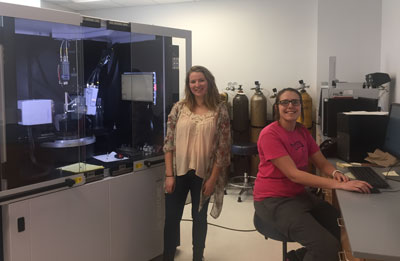



Nine students in the Department of Chemistry and Biochemistry representing sophomore, junior and senior classes are making an impact in the scientific community – one crystal structure at a time.
Their separate lab experiments produced two articles that were published in IUCrData, a peer-reviewed open-access data publication of the International Union of Crystallography. Both dealt with the molecular structure and crystal packing of a compound the students synthesized in their respective undergraduate laboratories.
 |
| Kathleen Hayes (left) and Emily Lasher, at their respective work stations. |
Four seniors – Joshua Deschner, Calvin Y. Wong, Ralph R. Crisci and Joseph Dragonette – and three juniors – Jack M. Choczynski, Kathleen L. Hayes and Emily Lasher – had their paper published in the Feb. 21 issue. They are enrolled in CHEM 481 Advanced Experimental Laboratory. Their article can be read online.
The article by sophomores Trent R. Howard and Kaleh A. Mendez-deMello appeared in the Nov. 29, 2016 issue. They are enrolled in CHEM 225 Organic Chemistry Laboratory 1. Their article can be read online.
Single crystal X-ray crystallography is a powerful technique used to determine the structure of a molecule as well as how the molecules/ions are arranged in solid state.
“When you go for an X-ray examination in a hospital the film will give you a visual representation of your skeleton. That is somewhat what we do with our samples; we use X-ray to get a visualization of the molecular backbone or carbon skeleton of our molecules. We bombard our samples (crystals) with X-rays which creates a diffraction pattern depending on how the crystal deflects the X-ray beam,” explained Visiting Assistant Professor of Chemistry and Biochemistry Allan Cardenas.
From the diffraction pattern, the electron density map can be plotted, a process that leads to determining how atoms are connected and how molecules are packed. In addition to applications in molecular chemistry, crystallography has a significant impact in material science and medicine, Dr. Cardenas noted.
The students demonstrated their synthetic and purification skills in preparing the samples. Each sample must be of high purity so it will produce crystals instead of powder. After their samples are prepared, they can be analyzed with a wide array of top-of-the-line instruments available in the Chemistry and Biochemistry department in the Science Center.